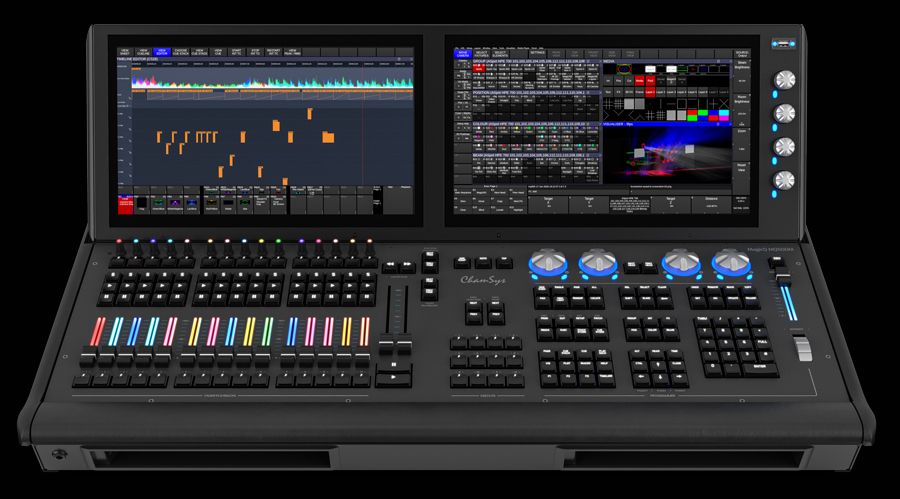You’ve been expecting it, here it comes! The MQ500 Stadium light desk is out now, with 15 motorized faders and software evolution under the MQ500M name. A nice gift for the lighting techies already fans of this brand, and possibly a triggering newbie for those hesitating ones, as its price is very friendly for a lighting desk now boasting 256 DMX universes.
We collected a bunch of infos from Ugo Knaff, Marketing Head at Sonoss, the French distributor for Chamsys. This new lighting desk uses the same software as the previous version, and this piece of brainwork will evolve for both versions in the future, except of course for the functions dedicated to the motorized faders operable only for the 500M.
Chamsys keeps a perfect compatibility between all OS and all software versions. This new function allows a quick reassignment of the playbacks between the compact models and the forthcoming Stadium series, still under development
Video presentation
15 motorized faders
On the MQ500M the 15 playbacks all have a motorized fader. Hence when changing your playback page the faders will automatically, visually and physically position themselves at the level of the active playbacks or at the programmed level if you turn on the option of “automated playbacks at page change”.
A brand new Bank function extends the page system: each playback page contains 6 Banks of 30 playbacks, corresponding to the 15 playbacks on motorized faders and to the 15 playbacks on encoders, and you can fly through the different banks by a long press on the page change buttons.
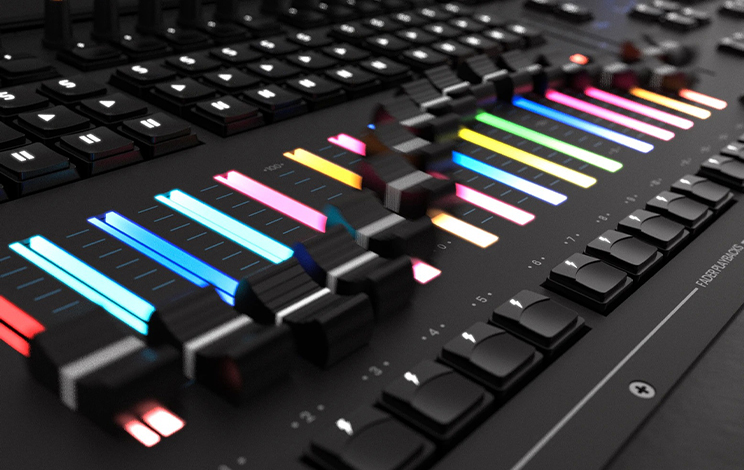
The motorization of the faders allows the ChamSys to offer other playbacks operation modes, as they can be changed on the fly as well: a control mode of the intensity of each fixture, another mode for the intensity level of each group, and a mode for the level of each DMX channel.
These modes operate at the programmer level and you can navigate between different machines / groups / channels using the page buttons. You can choose to use these modes on the whole patch or only on the current selection. Two other modes allow you to assign the Intensity Masters automatically for each machine or for each group.
To use the different modes or banks, you must by default make a long press on a physical key, then a second touch on the screen, but it is for example possible to directly assign the desired mode to one of the 12 physical buttons of the Execute keypad, which was already part of the MQ500.
You can therefore change the function of the playbacks on the fly, thanks to the motorized faders which can suddenly adapt at the same time physically the level from the one they’re already on, and go from a level sent by a playback to an intensity level sent by a group… A gift for all desk operators.
15 playbacks on potentiometers
The new potentiometers relating to the Flash buttons
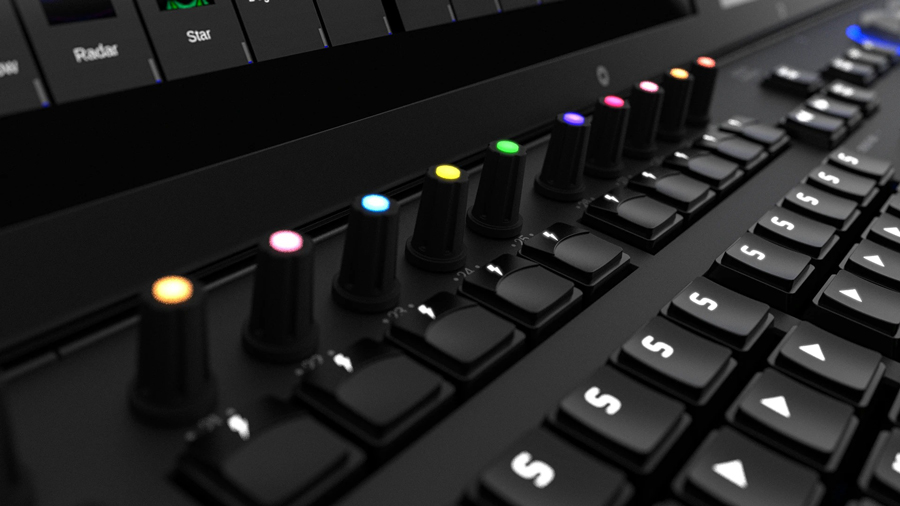
Above this row of 15 faders, as on the older version, are situated 15 additional playbacks. Each of these now has a potentiometer, where the previous version simply offered a flash button. It is therefore now possible to control the level of attributes sent for these playbacks.
New functions make it possible to exploit these new potentiometers, for example to control the amplitude or the speed of the effects recorded in a particular playback as well as in all the playbacks of the page or the bank.
Backlit faders and new touchbuttons
The motorized faders come as RGB backlit models in the 500M with the ability of choosing the color for each fader. It is the same for the new potentiometers situated above the playbacks. Other functions could be included in the future, like adjusting the parameters of the console so that each potentiometer indicator shows the color that the corresponding projector is showing in its very beam, to ease up the identification of the playbacks.
The buttons now have a new look and a softer feel. The button pads are also redesigned in a less dense way, and this is no extra luxury as it was difficult, unless you were a virtuoso, to instinctively find the key in the block of 15 buttons crammed together without looking for it visually. Blocks of 6 buttons will be easier to spot only (or mainly) by simple finger touch. The flash buttons also benefit from more “modern” touchbuttons.
Backlighting the console
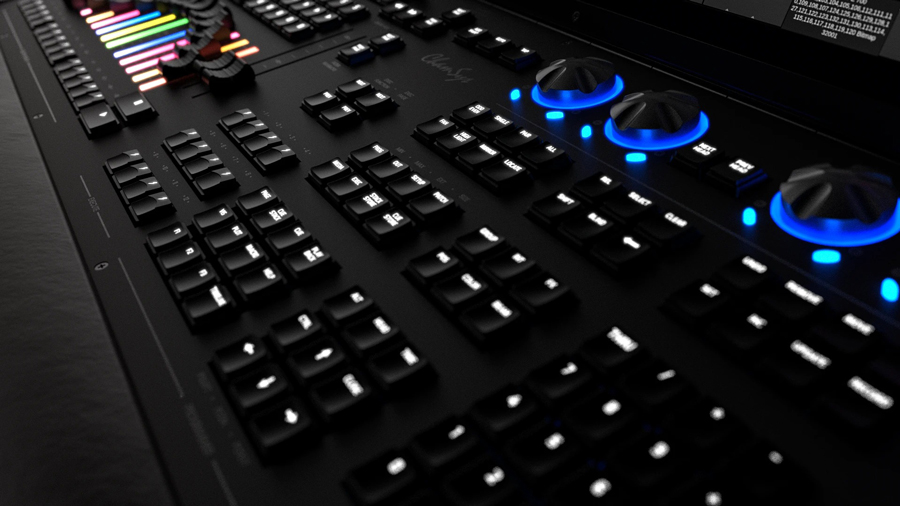
All the touchbuttons now include a white backlighting to gain more visibility in the darkness, and a red backlighting showing when a function or a page is active.
The Magix MQ500M also includes a plan view and a viewer, a timeline with audio functions, a color-picker adaptable to all color mixing systems.
The 3D palette system and support for external XYZ trackers allow you to use innovative features to quickly set multiple projectors on lines, or track artists and moving objects.
The free software on PC
A new mode is now part of the software to solve the limitation problem of only 64 universes on PC which caused problems when pre-encoding a show intended to be later controlled by an MQ500. With 64 universes available on PC against 200 on the MQ500, to encode a big show on PC you had no other solution than to buy a dongle.
This new “Stadium” mode in the software will allow you to pre-encode 256 universes by disabling the network outputs of the software. This will allow Stadium users to pre-encode in the software without being then blocked in the field by a universes number limitation.
Remember that the basic software allows you to output 64 ArtNet or sACN universes and convert them to DMX using any node, Luminex for example, and this is quite generous for a free software. For more physical control, of course Chamsys offers wings…
A new MQ500M Wing
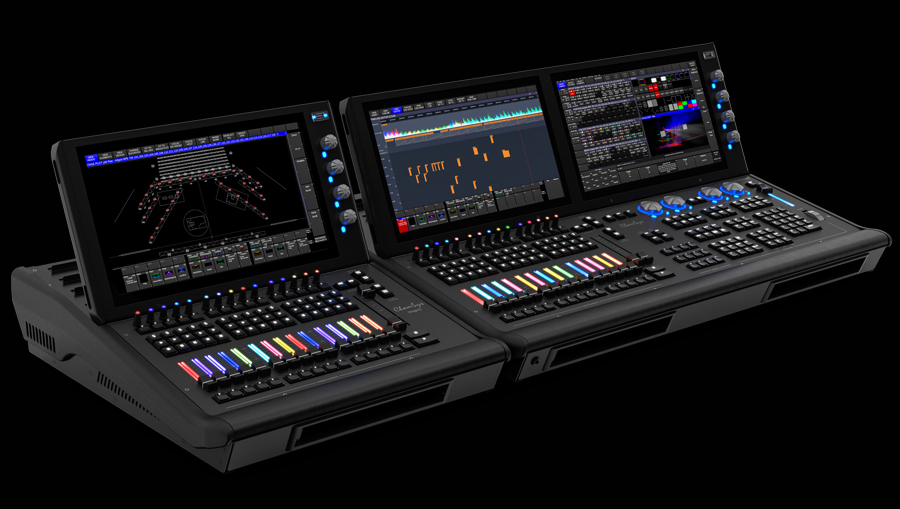
To extend the control surface of the 500M, Chamsys is now launching the MQ500M Wing. It proposes 15 motorized faders and 15 potentiometers as well as a 15-inch touchscreen, just like in the MQ500M. Its 4 additional DMX outputs allow the MQ500M to use directly 8 DMX outputs.
The MQ500M Stadium alongside the MQ500M Wing
Unlike the old Stadium Wing from which it is an evolution, and which could be used with the MQ80 or a MagicQ PC, its use is reserved for the MQ500M.
A kit to upgrade a MQ500 to a 500M.
Chamsys does not leave the many owners of the MQ500 on the sidelines by offering them the possibility of upgrading their console to MQ500M. This upgrade kit includes the replacement of all electronics and PCBs located directly below the control surface as well as a new storage system. This will require a return to your local distributor, in this case (in France) Sonoss.

The console will therefore be boosted to 256 universes. Its look will be a little different from that of the new model to avoid replacing all of the front panels, but the functions will be identical. Existing flight cases can therefore be used the same as before.
Up to five additional touchscreens can be connected to the system comprising a MQ500M and its MQ500M Wing, which makes an impressive total of 8 screens.
Keep cool and confident, Chamsys will maintain its policy of continuous improvement, whether software or hardware in this specific case, avoiding as much as possible technological breakthroughs that could prevent users from switching from one desk to another. Chris Kennedy is still at the helm of Chamsys with strong ideas at this (high) level.
List price:
– MQ500 M: 26,550 € HT
– MQ500M Wing: 8,340 € HT
– Kit faders motorisés: 6,450 € HT all inclusive global changeover from a MQ500 to a MQ500, including manwork and shipping costs back to you from Chamsys factory.
The MQ500 will be scratched from the Chamsys list of products in the forthcoming months but it will always keep the compatibility of the software and will benefit from the new functions to come, except of course those only devoted to the motorized potentiometers.
Availability : first deliveries September 2020.
More information on the Chamsys Website.



